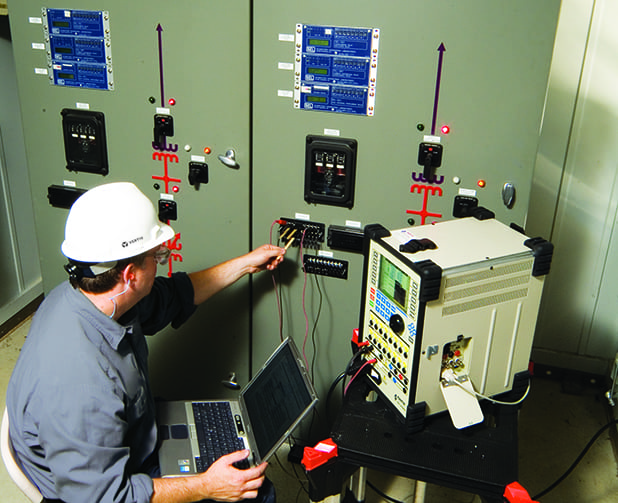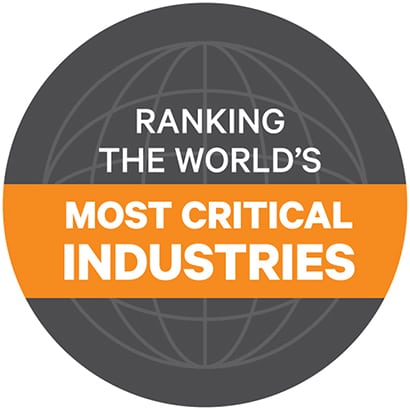Four Tips for Protecting Power within One of the World’s Most Critical Industries
New report highlights criticality of utilities.
As more and more industries increasingly rely on information technology (IT), the ability to ensure IT systems stay up and running is more critical than ever. But which industries absolutely, positively must stay up and running? Which industries are most critical?
That’s the question answered by a team of experts as part of the “Ranking the World’s Most Critical Industries” report recently released by Vertiv. This report ranks the top seven critical industries based on the impact of a disruption in that industry. It’s probably no surprise that utilities—defined in our analysis as nuclear power; gas service; water treatment; and electric generation, distribution, and transmission—top the list.
Ranking Industries
A global team was brought together to conduct the ranking. First the team identified 15 criteria (Figure 1) that define critical systems. The group then weighted each to create a “criticality rubric.”
 |
1. Criticality criteria. Fifteen criteria that define critical systems were identified and then weighted to create a “criticality rubric.” Courtesy: Vertiv |
From there, each member of the team assigned a value from 1 to 5 for each criterion within 22 industries. When the weights were applied to these values, an aggregate score for each industry was computed. Averages for each industry were then calculated to develop a list of the most critical industries. The criteria that were part of the team’s criticality rubric encompassed the range of potential impacts from the loss of availability of critical systems.
With reliable power underpinning so many of the other services and systems we depend on daily, utilities had high scores in almost all the criteria in the criticality rubric. Downtime in this industry has an immediate and broad impact, can create societal disruption, and often ripples across other industries.
Many industries have protection against loss of utility service, such as an uninterruptible power supply (UPS) and backup generators, and these are very effective against short-term and isolated disruptions. But when large portions of the grid go down, as happened in the blackout that affected the northeastern U.S. in 2003, the disruptions are so widespread that the entire society is paralyzed.
How to Avoid Unplanned Downtime
Financial impact of unplanned downtime was one of the most heavily weighted criterion in the criticality rubric, and one that tends to drive new technologies and best practices in critical infrastructure. Following are four best practices for utility owners and operators that will not only help improve infrastructure performance, but will also help avoid the costs that could accompany an unexpected utility outage.
Safeguard Power with Regular Maintenance. When a utility experiences a fault or other conditions that cause power failure, it causes the shutdown of critical processes and systems that can put the environment and public safety at risk.
While it’s normal for electrical equipment to age and subsequently deteriorate, it does not have to fail. Proactively performing preventive maintenance is the best approach for detecting and correcting factors that lead to deterioration. These maintenance services address critical components, including batteries, circuit breakers, relays, cables, transformers, and more, to prevent accidents and save lives. Additionally, it gives owners the system insight needed to minimize costly breakdowns and reduce unplanned outages (Figure 2).
 |
2. Relay testing. Proactive maintenance and testing can help identify problems before equipment fails. Courtesy: Vertiv |
Despite understanding this reality, many plants still struggle to find the money, the time, or the expertise to implement maintenance practices needed to properly care for infrastructure and keep up with ever-changing regulatory requirements.
Elements of a good preventive maintenance program should include:
- Identification of equipment or systems that may malfunction.
- Establishment of schedules and procedures for routine inspections that are in accordance with original equipment manufacturer (OEM) recommendations and applicable standards such as those from the North American Electric Reliability Corp. (NERC), National Fire Protection Association (NFPA), and InterNational Electrical Testing Association (NETA).
- Prompt repair or replacement of equipment identified as defective.
- Easy access to spare parts for equipment that is deemed critical.
- Use of an organized record-keeping system to schedule tests, and document inspections and trends.
- Evaluation of trends and subsequent adjustments to procedures and programs.
- Commitment to ensure that records are complete and detailed, and that they record test results and follow-up actions.
- Preventive maintenance inspection records kept with other visual inspection records.
- Use of an accurate, up-to-date, and legible single-line diagram.
Utilize Online Predictive Diagnostics. Imagine knowing well in advance that a system failure is going to occur. With this knowledge, actions can be taken to correct power system issues, effectively preventing unplanned outages and the high costs that come with them. This is exactly what predictive maintenance services, like infrared testing and partial discharge testing, are designed to do.
For example, partial discharge testing of circuit breakers, transformers, switches, busway, and cables can help identify insulation deterioration, which is the leading cause of electrical failures per NFPA 70B. These small electrical sparks are often present in insulation well in advance of failure, and thus are an important indicator of system problems. Through online and offline testing, along with monitoring of electrical assets, plant operators and maintenance personnel can gain important insight into the quality of insulation and its impact on overall equipment health.
Infrared testing (also known as thermographic imaging) is another important predictive diagnostic that should be performed routinely. These tests look for excessive heat that can be a sign of corrosion, loose connections, misalignment, or overload conditions—all problems that can result in potentially serious issues for utilities if left unchecked. By finding trouble spots, and acting to correct them before failures occur, owners can make the best use of maintenance dollars and avoid full-blown disasters.
Address Aging or Obsolete Infrastructure. One of the biggest hurdles to proper power system protection is aging and obsolete equipment. Worn equipment comes with a higher risk for failure and increased maintenance requirements, and it can pose additional safety risks for employees. But the cost of complete system replacement is usually not an option given today’s tight budgets.
Life-extension services, such as retrofits and renewals, can often be performed at a cost savings of up to two-thirds the cost of new replacements. Such services can restore power systems to OEM specifications, improving the efficiency and reliability of equipment. Many renewal services even include warranties on parts and labor.
A UPS renewal may include the replacement of major system components and the modernization of control systems for the UPS, inverter, and/or battery charger. Such a service should also include testing and calibration to ensure system performance is optimized.
Beyond the UPS, one of the best values in equipment upgrades for power systems is the replacement of electromechanical relays. This is a cost-effective way to leverage the advantages of microprocessor relays without the expense of installing new switchgear. Upgrading to microprocessor relays adds the benefits of self-testing, event reporting, fault identification, and arc flash mitigation. These advantages make troubleshooting and maintenance easier and safer. Plus, microprocessor relays provide the system information needed to more easily comply with International Electrotechnical Commission (IEC) Standard 61850.
Ensure Regulatory Compliance. The Occupational Safety and Health Administration (OSHA) provides the legal requirements for employers to ensure a safe work environment, and its regulations are enforceable under federal law. NFPA is the world’s leading advocate of fire protection, and its consensus codes and standards outline specific procedures for meeting OSHA requirements. Together these groups work to ensure safe working conditions.
In addition to addressing health and safety standards, there are ever-changing reliability standards that should also be top of mind for utility owners and operators. NERC has developed several regulations requiring plants to implement an ongoing and systematic program to test, maintain, and document the performance of protection scheme devices and other components that impact the bulk electric system (BES). Two groups of standards—several of which require a demonstration of compliance in the near term—include those associated with protection and control (PRC) and modeling, data, and analysis (MOD).
Becoming a Top Performer
As seen in the “Ranking the World’s Most Critical Industries” report (Figure 3), traditional industries, such as utilities, interconnect with most other industries. They provide the day-to-day services that allow people to function in their personal and business lives. Clean power and water are fundamental needs in a developed society, which is why avoiding unplanned downtime is paramount.
 |
3. Top of the list. Utilities ranked No. 1 of the 22 industries analyzed in the Vertiv report. Courtesy: Vertiv |
As an owner or operator, safeguarding the critical infrastructure that supports a plant is critical. Doing so starts with implementing a regular program of preventive maintenance, ideally one that includes predictive diagnostics. The information gained during these services is essential to asset management, especially when determining how to address aging or obsolete equipment.
Upgrades and retrofits are not only cost-effective solutions for improving a plant’s performance, but they can also make the working environment safer. With some upgrades, such as a change to microprocessor relays, compliance efforts can even be streamlined. Ultimately, partnering with a dependable expert can help ensure compliance with all applicable standards, and that can improve a utility’s operations and ensure maximum reliability is achieved.
—Tom Nation is vice president and general manager of Americas Services for Vertiv.